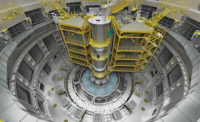It's time for public agencies to embrace the shift to digital construction project delivery, David Unkefer, senior construction engineer at the Federal Highway Administration, told construction sector professionals at ENR's FutureTech conference on June 9.
His agency is looking to go fully digital for greater productivity in project delivery and asset management, and welcomes use of alternative contracting methods that integrate design and build and allow for post-construction data management, he said—highlighting its support of an initiative to adopt proven technologies such as e-tickets and digital as-builts and building a pooled database to create GIS data for use on projects.
"We want to eventually create a workflow that uses 2D overhead view integrated with 3D data at scale," said George Lukes, state design and standards engineer at the Utah Dept. of Transportation, who presented with Unkefer. The senior project executives said many transportation engineers and contractors are trying to work with next-generation BIM tools that are still not fully meeting the needs of transportation, as well as shortcomings in volume calculations and field quantities where recent use of drones and LiDAR has yet to reach unified standards for data delivery.
ENR's 17th FutureTech, a three-day construction technology demonstration and networking event in San Francisco concluding on June 10, focused on advances in transportation project design and delivery, safe use of robotics on the jobsite and the promise of artificial intelligence for everything from optimism bias elimination in scheduling to application to image-based progress tracking.
Attendees shared strategies about how construction, design and energy technology—such as digital twins, sensors utilizing the internet of things and several uses of AI—an be applied to recurring project execution challenges. Among the AI innovations discussed were operation of automated excavators from Built Robotics trenching on Bechtel's utility-grade solar energy generation projects and autonomous rovers used by NextEra Robotics to capture in-progress work images for Gilbane Building Co.
Lana Graf, a partner at NextEra Robotics and an AI and Deep Tech investor with the International Finance Corp., said that AI and manufacturing processes are just now making autonomous robotics in construction viable, The solutions NextEra helped Gilbane use on its projects focused on eliminating construction productivity gaps, better quality control, increasing speed of construction and reducing waste.
AI: Best Case Scenarios
Bechtel Chief Innovation Officer Keith Churchill and Ken Burke, the firm's Global Operations Manager in equipment explained how Built Robotics was able to create fully autonomous excavators that dig trenches for major solar farm projects in Texas and Louisiana. Built Robotics Vice President Gaurav Kikani stressed that repetitive tasks where safety can be controlled—such as trench digging—are the best use-case scenarios for autonomous robotics such as on the firm's excavators.
Churchill said the competitive labor market allows skilled operators to manage the work of the autonomous excavators rather than spend hours at a time digging trenches. Kikani said the close work Built Robotics did with Burke's team in Bechtel's Houston area equipment lab allowed the firms to optimize the autonomous excavators. One safety measure was using a geo-fence with all personnel instructed to stay out of it for the autonomous excavators to dig their trenches in.
Eric Cushman, operations manager of Gilbane's Connecticut business unit, agreed that repetitive tasks that do not take advantage of skilled workers' talent and experience are the best use cases for robotics in construction.
A final use of AI was explored by Wan Li Zhu, co-founder and managing director at Suffolk Technologies, and Dev Amratia, CEO of nPlan—one that took it entirely out of the field.
Suffolk is trialing nPlan’s schedule analysis tool, which it says can reveal when project schedulers’ "optimism bias" creates a risk because insufficient time or resources are allocated for on-schedule activity completion. nPlan bases its recommendations on its AI comparing new schedules being studied against its database of 500,000 construction projects representing $1.4 trillion of work, and their activity-by-activity outcomes.
"Our algorithms ingest historical scheduled data. They see the monthly pay, the baseline schedule, and the every-month progress update, all the way until the as-built file, Amratia said. "We see what the original assumptions were, and what actually happened—which is reality."
Biases can come from data sets themselves, Amratia said. Artificial intelligence developed by companies such as nPlan and Doxel can identify hiccups in schedules before they happen in the field.
Energy When You Need It
One developing technology arena explored by the more than 500 architects, engineers, construction professionals and vendors attending tackled the ongoing problem of renewable energy storage with a gravity-based approach.
John Jung, president of Energy Vault Solutions, explained that the aging infrastructure of energy grids, in the U.S. and abroad, needs better long-duration energy storage. Whether it's AC or DC power, the rolling blackouts, unexpected grid destabilization and costly high-use days are forcing utilities and grid managers to add new and innovative storage options. Jung said this will affect how contractors will need to work to deliver next-generation facilities.
Energy Vault's solution uses the inverters and turbine-turning principles of pumped hydroelectric power but without the water—using gravity instead. Excess potential energy comes from the basic equation of potential energy equals gravity times mass times height. By hoisting and holding at height 30-ton mobile masses, Energy Vault's demonstration project in Italy has already shown they can store excess generated energy as potential energy. The company is now moving toward building functional energy storage sites connected to real power grids.
"The mission is to accelerate decarbonization of our planet by introducing the most sustainable and economical energy storage techniques," explained Jung. Energy Vault wants to, eventually, sell its products to utilities, independent power producers and large industrial energy users to reduce their overall cost of energy.
James Lutterbach, a principal of civil engineering software developer Unified Informatics in Indianapolis, noting a "fivefold return on investment" in attending Future Tech, said "you have people here who are passionate about innovation, sharing their ideas."





Post a comment to this article
Report Abusive Comment